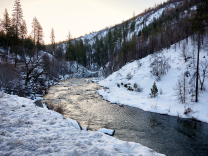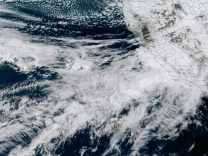
Next Up:
0:00
0:00
-
Listen Listen
Climate & Environment
Temperatures in Southern California will drop to the mid 60s to low 70s.
Sponsor
More Stories
-
As storms melt snowpack, managers released water to prevent reservoirs from overflowing and flooding Central Valley towns — and that sends water into the ocean. The warm rains melt snow that ideally would last into spring and help with water deliveries.
-
Forecasts put much of the state at risk for flooding over the next 1 to 7 days — although most of that danger is north of Los Angeles.
-
Even California communities accustomed to serious winters are struggling to deal with the consequences of continued extreme weather.
-
National Weather Service reports rain is expected to return Thursday — with the heaviest showers north of L.A.
-
It was so nice to see white sprinkled on the hills around our valleys.
-
In his initial climate budget proposal, the governor has cut about $561 million from local coastal resilience projects. Legislators, cities express concerns.
-
National Weather Service reports rain will make its way into Southern California starting Thursday.
-
There’ve been a few unprecedented weather events recently.
-
A new UC Berkeley study says there's been a 40% decline of L.A.'s bird species in the last century due to hotter temperatures and urban development.
-
We asked six climate experts what questions you should ask yourself whenever you come across something claiming to be a "climate solution".
-
Caltrans officials said Sunday: "Keeping people off our roadways helps our operations continue to move forward."
-
Large swaths of the U.S. have faced an intense winter storm over the past several days. In Southern California, authorities said it may take a week to clear roads in some mountain communities.
A slightly warmer day on tap, with highs in the mid 70s and blustery conditions.
Support your source for local news!
In case you missed it
-
911 recordings obtained by LAist shed light on why and how emergency planning continues to leave people with disabilities behind.
-
LAist investigates illicit dumping at three Antelope Valley sites.
-
An LAist investigation found toxic heavy metals in samples of fire retardant collected from the Palisades, Eaton and Franklin fires. Here's what that means.
More Stories
-
It's unlikely to get above the low 60s in most areas.
-
Warmer sea waters have many far-ranging effects. In the new pattern, some parts of the U.S. could get relief from drought, while others might see fewer hurricanes.
-
The bulk of the storm is moving from the Los Angeles basin into Orange and San Bernardino counties, where half an inch of rain is expected on the coast, along with an inch in the mountains.
-
A young black bear, dubbed BB-12, was captured and collared last month in the western portion of the Santa Monica Mountains.
-
The National Weather Service issued a winter weather advisory for local mountains as the storm moves in.
-
The hub of many weddings and events has been a cultural pillar of San Clemente and is now yellow-tagged. The back terrace has broken off and a garden has been ruined.
-
No more eateries in those areas can serve up single-use plastics or Styrofoam. There are some exceptions.
-
Most of the region from Los Angeles and Orange County to the Inland Empire will see light, scattered drizzling across the area this week.
-
The owls have all but completely disappeared from coastal Southern California.
-
The rules passed by the state Air Resources Board are the first of their kind — anywhere — and will likely have ripple effects, particularly in Southern California communities that have some of the dirtiest air in the nation.




































